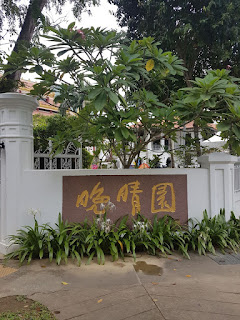Sun Yat Sen Memorial Hall
 |
| Wan Qing Yuan |
The location of the memorial hall is exactly where Dr. Sun Yat Sen resided and had his plans for the 1911 Chinese Revolution crafted with his team of revolutionaries. This was the HeadQuarters of the many branches of 同盟會 (Tong Meng Hui) across South East Asia.
 |
| History of Wan Qing Yuan |
 |
| The Statue of Sun Yat Sen |
The visit to this place left the deepest impression in me (or us).
Our visit coincided with the celebration of the Mid-Autumn festival and it being a heritage site, the celebration was pretty grand and lively. However, we could hear ENGLISH contemporary music playing in the background the moment we stepped into the place.
It felt so uncomfortable and weird as the loud bases of the contemporary music did not fuse well at all with the overarching theme of the memorial hall -- which is to remember Sun Yat Sen who made a significant contribution on the Chinese Community in Singapore. As much as I (we) appreciate the efforts made in attempting to create the atmosphere of a celebration, I (we) thought the choice of music was really inappropriate and it just felt incomprehensibly uncomfortable.
Delving on to the amusements in the museum, there were 2 main things which caught my (our) attention:
1. The clothing worn by the historical figures featured reflects culture of the West.
If you were to zoom in carefully at this photo, you will realise that most of them were wearing clothes which resemble cultures of the West more than the Chinese's. This highlights that despite Dr Sun Yat Sen and his team of Chinese 'missionaries' being revolutionary in their means to topple the Monarchy in the 1911 Chinese Revolution, as opposed to contrary belief that they were 'traditional', they are actually pretty 'Westernised' at that point in time when this photo was taken (~1912).
2. This huge painting of Dr. Sun Yat Sen and the masses.
At first glance, this painting really gives you the immediate impression that Sun Yat Sen was very popular amongst the common people. That smile on his face and how people looked earnestly at him as he speaks paints a heroic picture of him to be someone well respected by the masses.
Now, examine the drawing closely and see if you can challenge the narrative I have just described.
Do you see what we see?
If you were to zoom in to the bottom left corner of the painting where the females were drawn, you'd realised the first impression of this painting is not without its discrepancies. Most of the females were drawn to seem uninterested in what Dr Sun Yat Sen was saying -- one even gave the 'sian' look which highlights how disengaged she was with Dr Sun Yat Sen. These details suggest to us that Chinese nationalism which Dr Sun was advocating in Singapore only appealed mostly to the males and possibly reflect that Dr Sun did not have the support of everyone which was widely propagated.
(Credits to Jerome for analysing this portrait like a Historian and pointing out the detail which most of us could have possibly missed)
By the way, we were told that we missed an interaction with the artist of this particular painting by just 20 minutes.... )-:
3. The principle of jus sanguinis
 |
| 'Lets stand in solidarity to save the country' Country = China Context: To save China from the monarchy under the Qing Dynasty |
Such slogans were propagated amongst the Chinese Community in Singapore to garner overseas support of their nationalistic efforts back in mainland China when they were preparing for the 1911 Chinese Revolution. Doesn't this reflect the principle of jus sanguinis which we are exposed to in our recent lecture on Nationalism?
4. The memorial hall was a reflection of the 'Great Men Theory of History'.
From the paintings exhibited, to the narration of Dr. Sun Yat Sen and how he founded Tong Meng Hui to becoming Kuo Ming Tan subsequently, really reflected the dominant narratives of Dr. Sun that we are familiar with.
While we had a consensus that this memorial hall could be more objective if it had featured and openly displayed the failures/shortcomings of Dr. Sun, we kept in mind the purpose of this exhibition -- to remember and commemorate the works of Dr. Sun and his team. With that, we conclude our trip to this memorial hall by taking away that museums are......outrightly biased.







Comments
Post a Comment